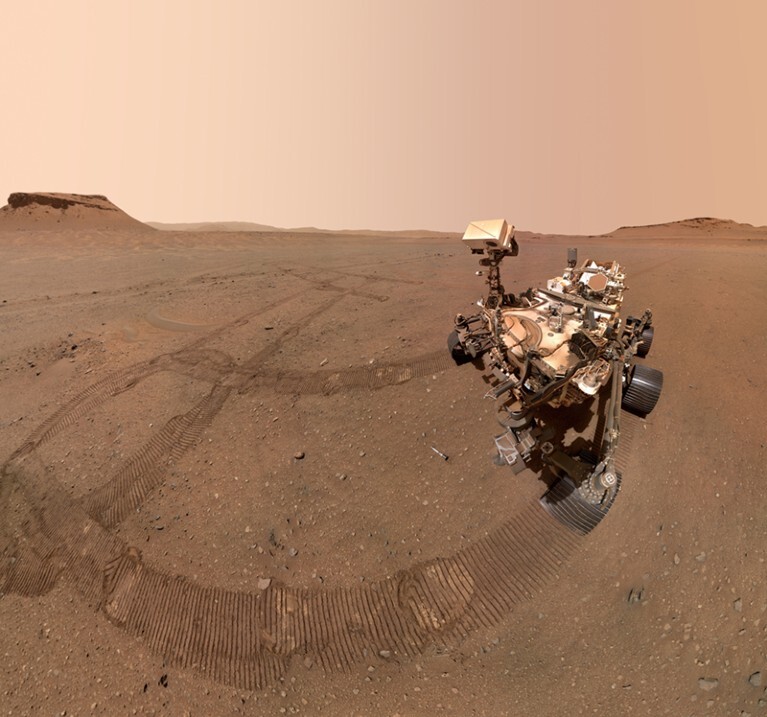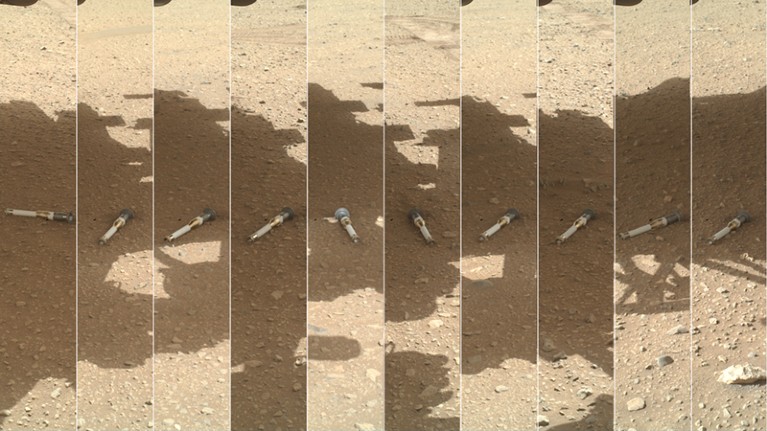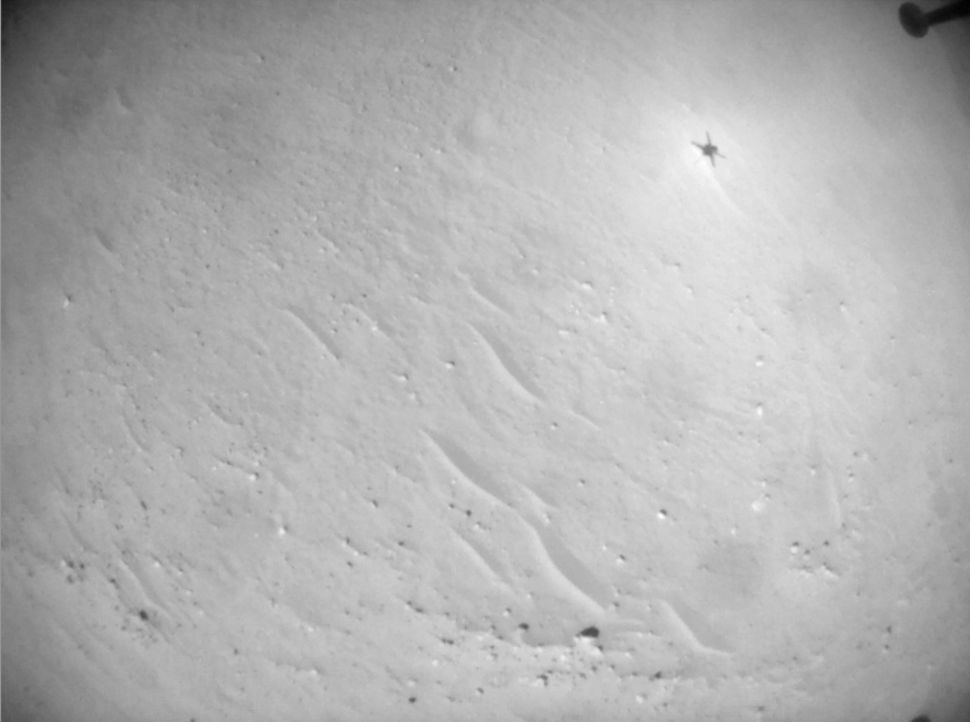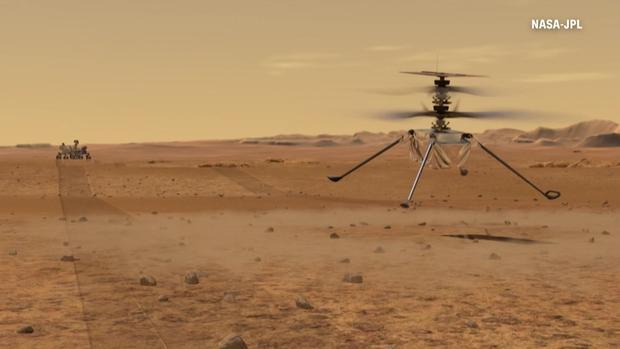12.03.2023
NASA's Ingenuity helicopter captures breathtaking shot of Martian sunset (photo)
Ingenuity snapped the shot on Feb. 22, during its 45th Red Planet flight.
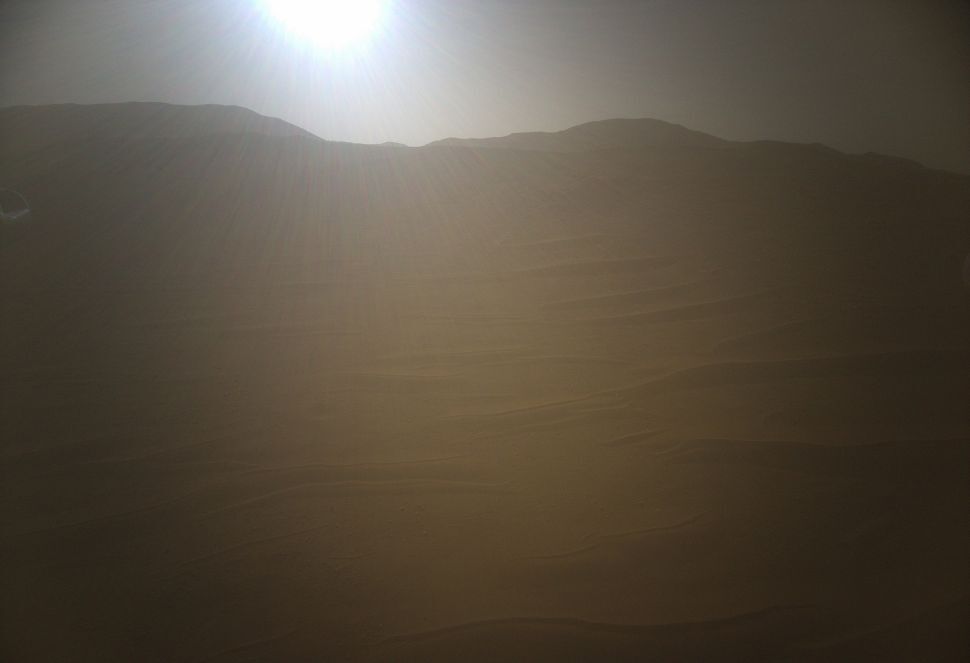
NASA's Ingenuity helicopter captured this photo of the sun setting on Mars on Feb. 22, 2023, during its 45th Red Planet flight. (Image credit: NASA/JPL-Caltech)
NASA's Ingenuity Mars helicopter recently took to the skies for its 45th flight, traveling nearly one-third of a mile (0.5 kilometers) — and snapping a gorgeous shot of a Red Planet sunset in the process.
Ingenuity is still making short flights around Mars' Jezero Crater, continuing to gather data well beyond its operational life expectancy. Ingenuity arrived on the Red Planet aboard NASA's Perseverance rover, which landed on Jezero's floor in February 2021.
Ingenuity flew for the first time two months later, in April 2021, and was originally tasked with only a few test flights to prove its pioneering technology. However, having exceeded NASA's expectations, Ingenuity's mission expanded to serve as a scout for Perseverance, which is searching for signs of ancient Mars life and collecting samples for future return to Earth. Ingenuity has now flown a total of 46 times, with an accumulated distance of 6.3 miles (10.1 km).
Flights 45 and 46 occurred just three days apart, on Feb. 22 and Feb. 25, with a 47th flight expected any day now. Depending on the relative positions of Earth and Mars, a transmission between the two planets can take anywhere from 5 to 20 minutes to reach its destination. Because of this, Ingenuity is designed to take off, fly and land on its own. Mission controllers program each flight, then must wait for data confirmation that Ingenuity has safely landed. Onboard cameras capture images used to help determine both Ingenuity and Perserverance's next steps.
Ingenuity's high-resolution color camera is angled 22 degrees below the horizon. Images relayed back to NASA from the 4-pound (1.8 kilograms) chopper are therefore primarily focused at the ground, searching for interesting geological features and potential obstacles ahead.
Occasionally, however, a sliver of Martian sky will make an appearance in one of Ingenuity's photographs, serving as a reminder that the rotorcraft is giving us a whole new perspective on the Red Planet. The helicopter captured such an image on its 45th flight, but with an even rarer subject in frame — the sun.
The photo shows the sun hanging slightly above the horizon of hilltops in the distance, caught in the process of setting on Ingenuity's 714th Martian day, or sol. The rays shining across the photograph help illuminate the rolling alien landscape of sand and rocks inside Jezero Crater, and it almost feels like a photo you could capture from a desert here on Earth. And therein lies its beauty.
These perceived similarities shape the foundation of why we explore space in the first place. That a sunset photo from a different planet can remind us so much of our own highlights the thin margin between our life-sustaining Earth and other lifeless worlds orbiting our sun and beyond. It symbolizes the very nature of Perserverance's search for ancient Martian life, and begs the question of what sunsets on what other worlds might look like — and if humanity will get to witness those someday, too.
Quelle:SC
----
Update: 16.03.2023
.
Liftoff on Mars! Perseverance rover captures amazing video of Ingenuity helicopter flight
The helicopter made its 47th flight, putting it well within sight of making 50 launches on the Red Planet.
A Mars drone busted out some midair moves on the Red Planet during its latest flight.
Footage of Ingenuity, the Mars helicopter drone flying alongside the Perseverance rover mission, shows the mini-chopper ascending into the Martian hills behind it.
The 47th flight of Ingenuity on March 9 was expected to scout out science targets to the southwest ahead of bringing Perseverance in the direction to seek out evidence of ancient life on Mars, according to NASA's Jet Propulsion Laboratory's flight briefing(opens in new tab).
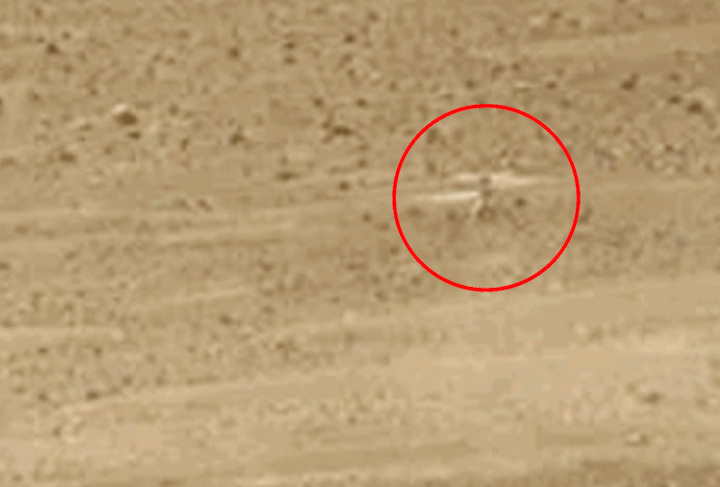
The Ingenuity helicopter on Mars during its 47th flight on March 9, 2023 via a camera on the Perseverance rover. (Image credit: NASA/JPL-Caltech
The flight covered 1,444 feet (440 meters) of flight distance and brought Ingenuity to a new pit stop, nicknamed Airfield Iota in the flight log(opens in new tab), after several previous flights between existing airfields. Ingenuity's top speed hit a typical 11.9 mph (5.3 meters per second), and the drone remains in good health as it shoots for Flight 50 in a few weeks.
Ingenuity and Perseverance also worked together to send home more imagery of the flight than usual, using satellites in orbit around the Red Planet and NASA's Deep Space Network, a busy set of antennas on Earth keeping track of deep-space missions.
Footage taken on Ingenuity's downward-looking black-and-white navigation camera shows Martian dunes whipping by underneath as the drone flew as high as 39 feet (12 meters), a typical altitude for these flights. Perseverance captured Ingenuity's soaring from afar using the rover's Mast-Z long-range camera.
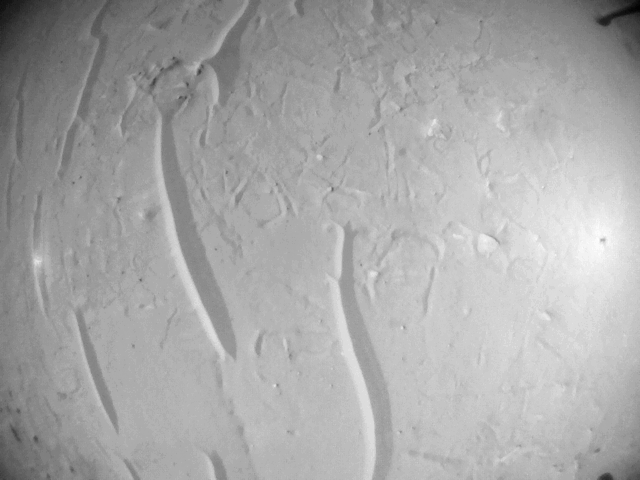
Ridged dunes fly underneath Ingenuity during its 47th Mars flight on March 9, 2023. (Image credit: NASA/JPL-Caltech
Ingenuity is not only scouting for Perseverance, but also serving as a testbed ahead of NASA's and the European Space Agency's sample return mission. Should Percy be unable to ferry the samples it picked up to a waiting spacecraft in 2033 or so, two backup helicopters will pick up twin lightsaber-shaped sample tubes the rover has been caching on the surface.
Perseverance and Ingenuity are together working on an eight-month campaign, nicknamed "Delta Top," exploring a region that may have had a life-friendly river delta and lake billions of years ago.
Quelle: SC
----
Update: 24.03.2023
.
Mars helicopter Ingenuity aces 48th flight on the Red Planet
The little chopper's most recent hop occurred on Tuesday (March 21).
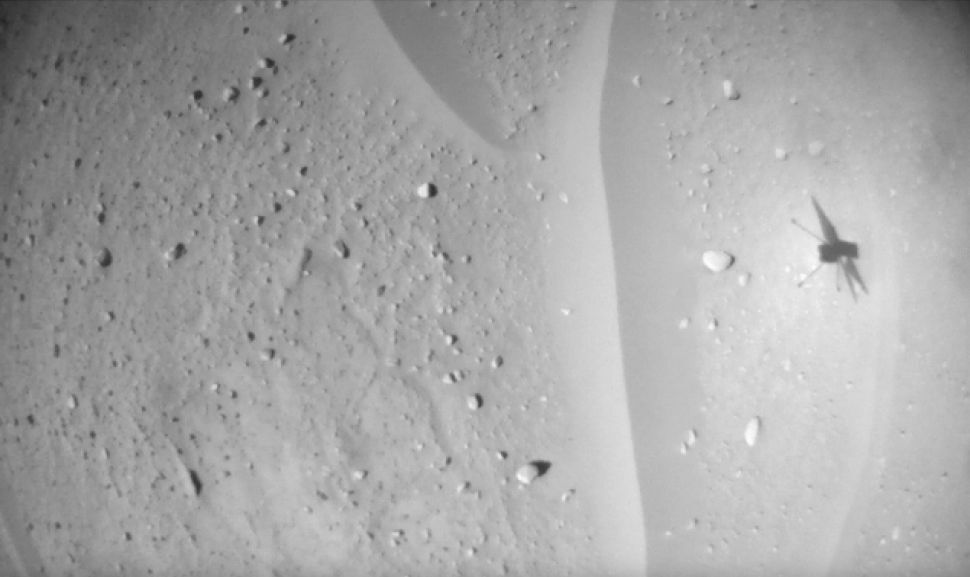
NASA's Ingenuity Mars helicopter captured this image of its own shadow on March 21, 2023, during its 48th flight on the Red Planet. (Image credit: NASA/JPL-Caltech)
NASA's Ingenuity Mars helicopter made its 48th off-Earth flight on Tuesday (March 21).
Ingenuity buzzed over the Martian landscape at a maximum altitude of around 39 feet (12 meters), observing potential science targets that could be studied by its robotic partner, NASA's life-hunting Perseverance rover.
Ingenuity traveled at a top speed of 10.4 mph (16.7 kph) during Tuesday's flight, which covered a horizontal distance of around 1,300 feet (400 meters) and lasted nearly 150 seconds, according to the mission's flight log.
Ingenuity, which in April 2021 became the first machine to achieve powered flight in the skies of an alien world, is now well on its way to a milestone 50th flight.
March has been an important month for Ingenuity and its operators. Not only has the "Marscopter" made its 47th and 48th flights in March, but this month marks exactly one Earth year since the mission of the helicopter was extended by NASA officials.
"Less than a year ago, we didn't even know if powered, controlled flight of an aircraft at Mars was possible," then-NASA science chief Thomas Zurbuchen said in March 2022(opens in new tab). "Now, we are looking forward to Ingenuity's involvement in Perseverance's second science campaign. Such a transformation of mindset in such a short period is simply amazing, and one of the most historic in the annals of air and space exploration."
Ingenuity touched down on the Martian surface with Perseverance on Feb. 18, 2021. The helicopter, which weighs less than 4 pounds (1.8 kilograms), couldn't take to the Martian skies straightaway, however. It had to wait for Perseverance to carry it to a suitable "airfield" on Mars.
The rover reached such a site in April of that year, which NASA scientists named "Wright Brothers Field" in honor of aircraft pioneers Orville and Wilbur Wright, who are credited with making the first controlled, sustained flight of a powered, heavier-than-air aircraft here on Earth on Dec. 17, 1903.
On its 58th Earth day on the Red Planet, Ingenuity made its debut self-powered and self-controlled flight. During the flight, Ingenuity climbed to an altitude of just 10 feet (3 m), staying aloft in the thin Martian atmosphere for almost 40 seconds but not traveling horizontally, instead landing back in the same spot from which it lifted off.
Just three days later, on April 22, 2021, the helicopter made its second flight and its first horizontal jaunt across Mars, flying 13 feet (4 m) at an altitude of 16 feet (5 m) and staying airborne for around 52 seconds.
As of its most recent flight, Ingenuity has traveled a total of around 36,000 feet (11,000 m) across the Martian landscape, according to the flight log. The helicopter has reached a maximum altitude of 46 feet (14 m) and has hit a maximum speed of around 13.4 mph (21.6 kph). Its total time in the air is around 84 minutes.
Achieving such feats on the Red Planet takes a special craft indeed. Not only did Ingenuity have to be designed to be light yet strong enough to withstand the harsh conditions of Mars, but the helicopter also had to have enough power to take off in the Martian atmosphere, which is just 1% as thick as Earth's. This power is delivered by Ingenuity's counter-rotating blades that spin about 2,500 revolutions per minute(opens in new tab) (RPM). By comparison, an average helicopter's blades here on Earth spin at 400 to 500 RPM.
Ingenuity and Perseverance are exploring an area of Mars known as Jezero Crater, a region containing an ancient lake bed and river delta that around 3.5 billion years ago held lots of liquid water. NASA picked Jezero for Perseverance's mission chiefly because of the crater's past life-hosting potential.
Quelle: SC
----
Update: 25.03.2023
.
Perseverance rover snaps gorgeous shots of drifting predawn clouds on Mars (photos)
Perseverance keeps giving us stunning views of the Red Planet.
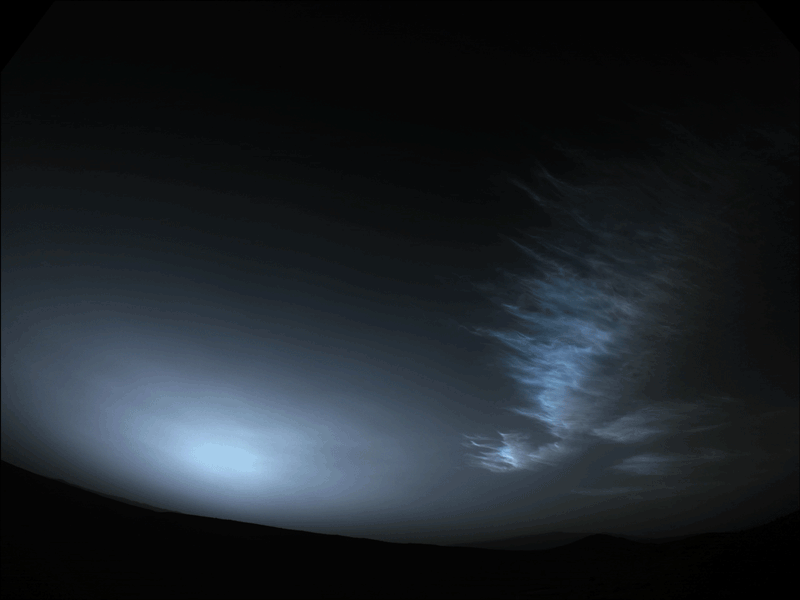
NASA's Perseverance Mars rover imaged drifting Red Planet clouds on March 18, 2023, the 738th Martian day, or sol, of the mission. (Image credit: NASA/JPL-Caltech
At least one interplanetary weather report dropped on World Meteorological Day.
NASA's Perseverance rover imaged drifting predawn clouds on the Red Planet recently, taking a brief break from its ongoing search for signs of ancient Mars life. Mars is a dry and dusty planet, but billions of years ago water likely pooled and flowed in many areas on its surface, providing a potential life-friendly spot for microbes.
The new cloud images, released by NASA's Jet Propulsion Laboratory today (March 23), were taken with one of the rover's navigation cameras just before Martian sunrise on March 18. That was the 738th Martian day, or sol, of Perseverance's mission; a sol is just a little longer (24 hours, 37 minutes) than a day on Earth.
The brief NASA release(opens in new tab) describing the clouds had no further information about what exactly is being studied.
Last year, however, NASA initiated a citizen science project probing Martian clouds, which are made up of carbon dioxide, also known as dry ice. Studying the clouds provides a window into conditions in the planet's middle atmosphere, at roughly 30 to 50 miles (50 to 80 kilometers) in altitude, officials said at the time.
Perseverance recently arrived at a new area nicknamed "Berea," where it is just about to further scrutinize an intriguing layered rock, mission officials tweeted yesterday(opens in new tab) (March 22). More generally, Perseverance and a little helicopter called Ingenuity are exploring an ancient river delta in Jezero Crater that may have hosted ancient life. Ingenuity will likely reach 50 flights, 10 times its original manifest, in the coming days or weeks.
Perseverance is also gathering samples for future return to Earth, a campaign that's a joint effort of NASA and the European Space Agency. That campaign's formulation is still being determined, however. The baseline plan released last year called for Perseverance to carry its samples over to a rocket-toting lander, which is scheduled to launch toward Mars in 2028. If the rover is unable to do that, two small helicopters aboard the lander will pick up the lightsaber-shapedsample tubes that Perseverance has placed on the surface as a backup plan.
But now NASA's Science Mission Directorate is considering changes to reduce the cost, such as having only a single helicopter fly aboard the lander in 2028, according to a livestreamed town hall meeting held earlier today that addressed NASA fiscal 2024 budget negotiations that are ongoing.
On our own planet, World Meteorological Day is celebrated annually on March 23 to commemorate the founding of the World Meteorological Organization on that day in 1950. The Intergovernmental Panel on Climate Change recently warned once again of dire consequences if humans ignore the perils of global warming.
Quelle: SC
----
Update: 2.04.2023
.
NASA’s Perseverance Collects First Mars Sample of New Science Campaign
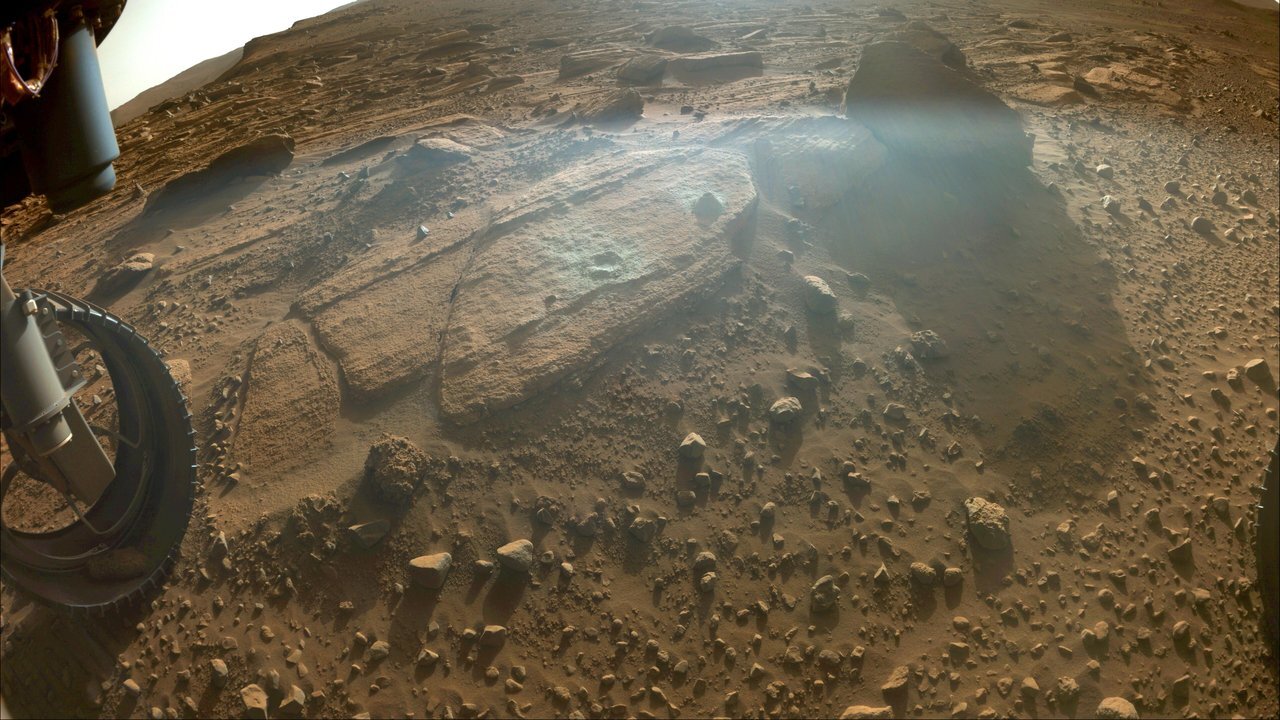
The rover continues its hunt for rocks worthy of bringing to Earth for further study.
NASA’s Perseverance rover cored and stored the first sample of the mission’s newest science campaign on Thursday, March 30. With each campaign, the team explores and studies a new area. On this one, the rover is exploring the top of Jezero Crater’s delta. Perseverance has collected a total of 19 samples and three witness tubes, and it recently deposited 10 tubes as a backup cache on the Martian surface as part of the NASA-ESA (European Space Agency) Mars Sample Return campaign.
Scientists want to study Martian samples with powerful lab equipment on Earth to search for signs of ancient microbial life and to better understand the water cycle that has shaped the surface and interior of Mars.
This animation shows NASA’s Perseverance Mars rover collecting a rock sample from an outcrop the science team calls “Berea” using a coring bit on the end of its robotic arm. The images were taken by one of the rover’s front hazard cameras.
Cored from a rock the science team calls “Berea,” this latest sample is the 16th cored rock sample of the mission (there are also samples of regolith – or broken rock and dust – as well as Mars atmosphere; read more about the samples). The science team believes Berea formed from rock deposits that were carried downstream by an ancient river to this location. That would mean the material could have come from an area well beyond the confines of Jezero Crater, and it’s one reason why the team finds the rock so promising.
“The second reason is that the rock is rich in carbonate,” said Katie Stack Morgan, deputy project scientist for Perseverance at NASA’s Jet Propulsion Laboratory in Southern California. “Carbonate rocks on Earth can be good at preserving fossilized lifeforms. If biosignatures were present in this part of Jezero Crater, it could be a rock like this one that could very well hold their secrets.”
A Climate Puzzle
One big puzzle is how Mars’ climate worked back when this area was covered with liquid water. Because carbonates form due to chemical interactions in liquid water, they can provide scientists a long-term record of changes in the planet’s climate. By studying the carbonate in the Berea sample, the science team could help fill in the gaps.
“The Berea core highlights the beauty of rover missions,” said Perseverance’s project scientist, Ken Farley of Caltech in Pasadena. “Perseverance’s mobility has allowed us to collect igneous samples from the relatively flat crater floor during the first campaign, and then travel to the base of the crater’s delta, where we found fine-grained sedimentary rocks deposited in a dried lakebed. Now we are sampling from a geologic location where we find coarse-grained sedimentary rocks deposited in a river. With this diversity of environments to observe and collect from, we are confident that these samples will allow us to better understand what occurred here at Jezero Crater billions of years ago.”

With this latest sample stored safely in a sample tube in the rover’s belly, the six-wheeler will continue to climb Jezero’s sedimentary fan toward the next bend in the dry riverbed, a location the science team is calling “Castell Henllys.”
More About the Mission
A key objective for Perseverance’s mission on Mars is astrobiology, including caching samples that may contain signs of ancient microbial life. The rover will characterize the planet’s geology and past climate, pave the way for human exploration of the Red Planet, and be the first mission to collect and cache Martian rock and regolith.
Subsequent NASA missions, in cooperation with ESA, would send spacecraft to Mars to collect these sealed samples from the surface and return them to Earth for in-depth analysis.
The Mars 2020 Perseverance mission is part of NASA’s Moon to Mars exploration approach, which includes Artemis missions to the Moon that will help prepare for human exploration of the Red Planet.
JPL, which is managed for NASA by Caltech, built and manages operations of the Perseverance rover.
Quelle: NASA
----
Update: 4.04.2023
.
First Mars Sample Depot shaped by Rover, Lander, and Helicopter
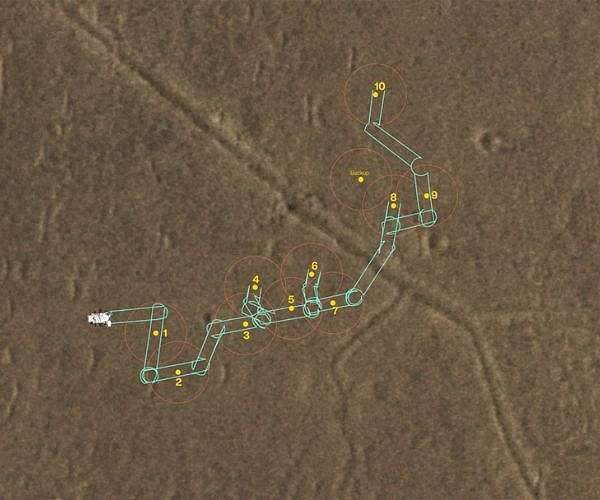
This map shows where NASA's Perseverance Mars rover will be dropping 10 samples that a future mission could pick up. The orange circles represent areas where a Sample Recovery Helicopter could safely operate to acquire the sample tubes. Figure A is the same map with a legend. A key objective for Perseverance's mission on Mars is astrobiology, including the search for signs of ancient microbial life. The rover will characterize the planet's geology and past climate, pave the way for human exploration of the Red Planet, and be the first mission to collect and cache Martian rock and regolith. Future missions will send spacecraft to Mars to collect these sealed samples from the surface and return them to Earth.
NASA's Perseverance rover is now exploring the upper surface of the Western Fan in Jezero crater, having completed a very successful one Mars year Prime Mission. It has sealed 22 of the 43 sample tubes it brought to Mars and created the Three Forks Sample Depot where it deposited 10 of these samples.
The Mars Sample Return mission aims to bring some of the samples that Perseverance collects from Mars to Earth via tube transfer to a Sample Retreival Lander, via either:
+ Perseverance Passes the Baton: In the primary plan, the Mars Sample Return Sample Retrieval Lander (SRL) will land close to Perseverance, which would then drive up to it. The lander's robotic arm would then transfer one tube at a time from Perseverance's bit carousel into the Mars Ascent Vehicle on the lander-a rocket that would launch the samples into martian orbit for rendezvous and capture by an Earth Return Orbiter (ERO).
As a backup plan, SRL would carry two Sample Recovery Helicopters (SRHs) to Mars.
+ Sample Recovery Helicopters Fly, Drive, Grab, and Drop: To hedge against anything unexpected preventing Perseverance from delivering samples to SRL, the rover collected twin samples at the first seven sampling locations so that one of each pair could be deposited at the Three Forks depot. Perseverance could also deposit a second depot in the future with more than 10 tubes for collection. The Sample Recovery Helicopters could fly to a sample depot, collect one sample at a time, fly back to the lander and drop it for the lander robotic arm to pick up from the surface.
So why did we create the Three Forks depot in that shape?
Recovery helicopter access was the biggest factor. Around the drop zone, a 5.5 meter (18 feet) radius circle had to be free of hazards for the SRH. The drop had to be within 70-95 centimeters (27.6-37.4 inches) of the center of this circle to allow it to encompass a donut-shaped landing zone and a central drive, grab, and go zone.
SRH is expected to weigh just 2.3 kilograms (5.1 pounds) including small wheels and a gripper for which rocks ~2 centimeters (0.8 inches) in diameter could be a potential hazard. The entire depot also needed to be within 200-700 meters (656.2-2296.6 feet) flight distance from a location for SRL landing.
+ No communication obstructions such as the rover body or terrain could block Perseverance's High Gain Antenna during the depot construction, since that is how the rover receives instructions. This had to be factored in for the approach and parking heading for each drop zone.
+ View of the next drop zone had to be unobstructed by the rover body to take high resolution images for checking recovery helicopter hazards.
+ Rover return access had to be maintained to allow driving through the Sample Depot after drops in case we needed to re-image or use the lower drill stabilizer tip to topple a tube that might have landed standing straight up. The SRH gripper arm is designed to pick up a tube lying horizontally on the ground.
While creating the depot, Perseverance alternated between two types of activities:
1/ Drop and image used choreographed moves between the Perseverance external robotic arm and the Adaptive Caching Assembly (ACA) inside the rover, which has a second robotic arm - the Sample Handling Arm - to image the sample before and after depositing it on the ground.
2/ Drive and photoshoot involved backing up and taking mid-drive images of the dropped sample - a 7inch (18.6cm) tube and glove combination, which is called an RGA (Returnable Sample Tube Assembly and attached Glove Assembly). Each drive concluded with a precision approach to place the ACA over the next drop zone.
The drive distances between drop zones ranged from ~8-22 meters (26.2-72.2 feet). If the RGA was dropped too close to a wheel (as found in some Earth testing), a RGA Avoidance Maneuver (RAM) was to be executed with the rover driving backwards to avoid rolling over the RGA. As it happened, the tubes on Mars all dropped nominally and Rover Planners didn't have to say "RPs are GO for RAM" and "RPs will commence RAMing."
During the 42 martian days (sols) that it took to to create and document the Three Forks depot, the rover drove 207.93 meters (682.2 feet), dropped 10 sample RGAs, and took 4000 images. The team gathered together in mission control toward the end of sample depot creation, and it was wonderful to take the time to appreciate the quiet geniuses in various areas who made it all seem so simple.
As we walked out of the room, the next uplink commanding the rover was already in progress as Perseverance moved on at a fast clip. It is now collecting single samples (instead of pairs) from each rock target to add to its collection before its rendezvous with the Mars Sample Return spacecraft to see samples launch from Mars for return to Earth.
Quelle: SD
----
Update: 5.04.2023
.
Mars rocks await a ride to Earth — can NASA deliver?

